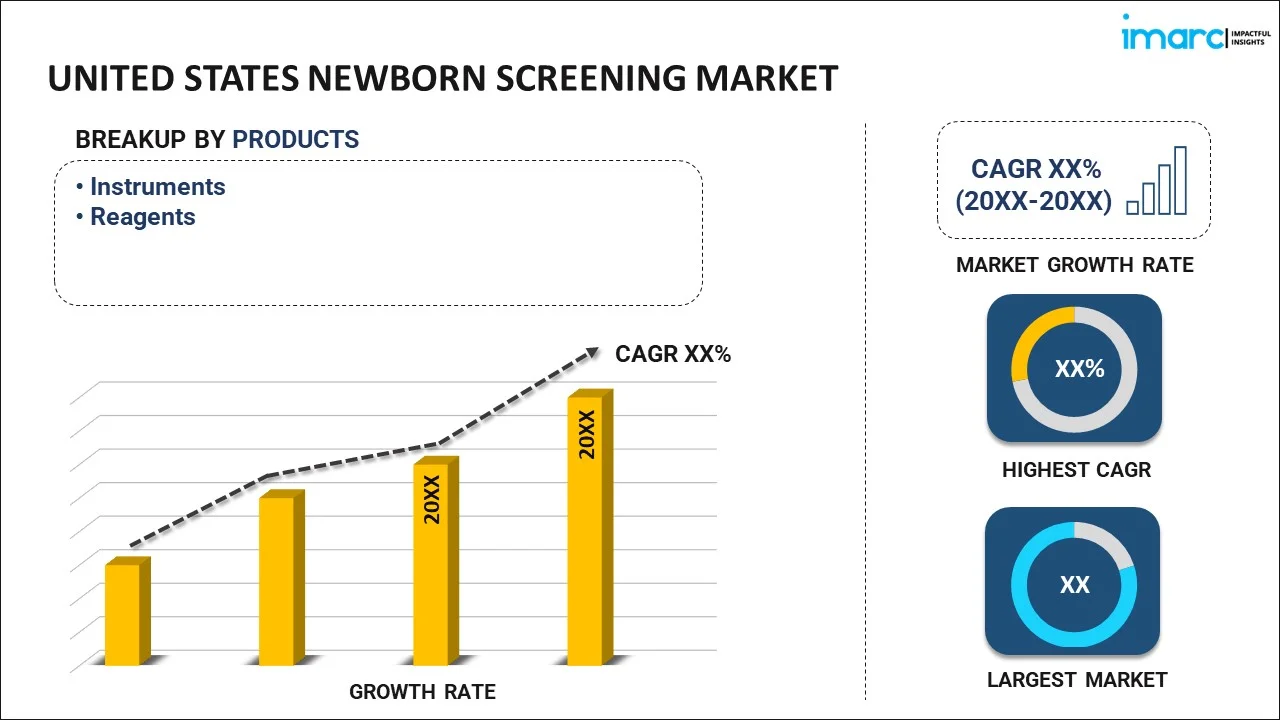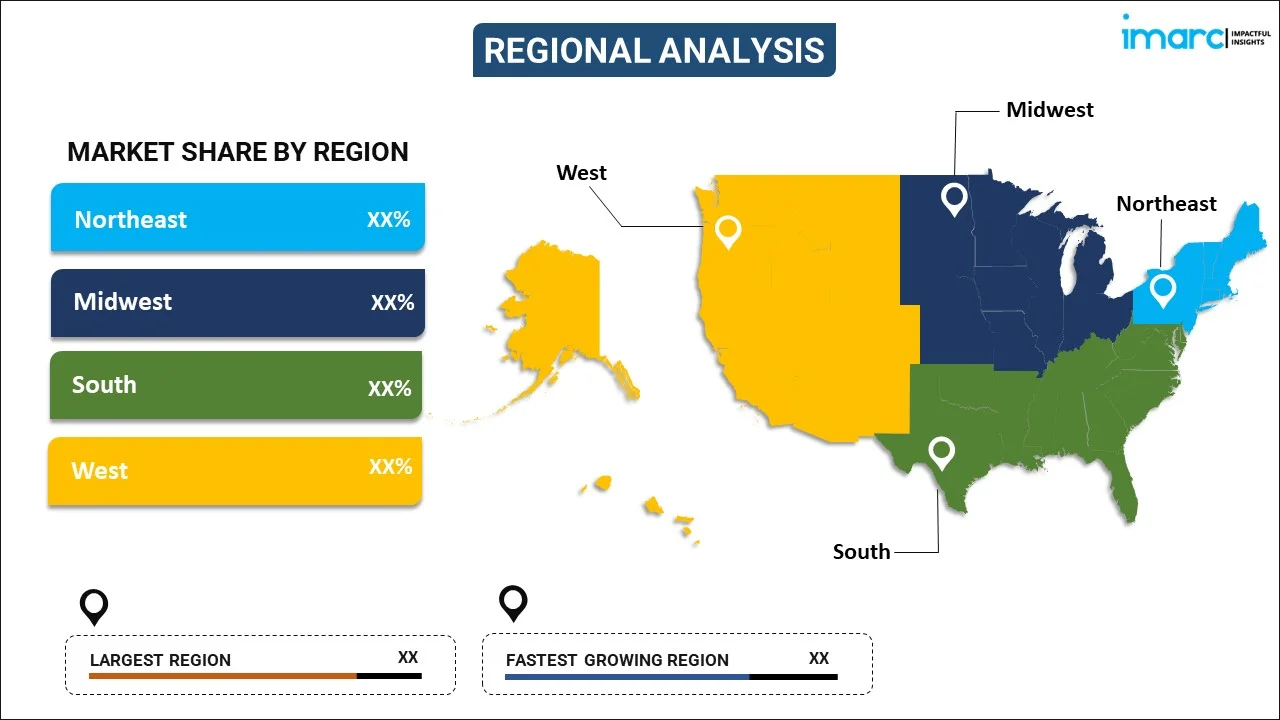
United States Newborn Screening Market Report by Product (Instruments, Reagents), Technology (Tandem Mass Spectrometry, Pulse Oximetry, Enzyme Based Assay, DNA Assay, Electrophoresis, and Others), Test Type (Dry Blood Spot Test, CCHD, Hearing Screen), and Region 2024-2032
Market Overview:
United States newborn screening market size reached US$ 101.3 Million in 2023. Looking forward, IMARC Group expects the market to reach US$ 202.3 Million by 2032, exhibiting a growth rate (CAGR) of 7.90% during 2024-2032. The rising number of screening panels in the healthcare infrastructures, coupled with the elevating integration of digital technologies, is primarily propelling the market growth.
|
Report Attribute
|
Key Statistics
|
|---|---|
|
Base Year
|
2023
|
|
Forecast Years
|
2024-2032
|
|
Historical Years
|
2018-2023
|
|
Market Size in 2023
|
US$ 101.3 Million |
|
Market Forecast in 2032
|
US$ 202.3 Million |
| Market Growth Rate 2024-2032 | 7.90% |
Newborn screening stands as a crucial public health initiative that is particularly designed to identify specific health conditions in infants shortly after birth. This essential process involves extracting a few drops of blood from the baby's heel, enabling the early identification of potentially severe conditions before any symptoms manifest. The scope of newborn screening encompasses the assessment of a diverse array of congenital disorders, metabolic irregularities, and genetic diseases. Beyond identification, this screening facilitates healthcare professionals in promptly implementing interventions and treatments, thus mitigating or preventing the adverse effects associated with these conditions. The significance of the process lies in its proactive approach, allowing for preemptive measures that can significantly impact the long-term health and well-being of newborns.
United States Newborn Screening Market Trends:
The United States newborn screening industry is experiencing significant growth, driven by the several factors and trends. Technological advancements play a pivotal role as next-generation sequencing and advanced molecular techniques enhance the precision and scope of newborn screening. These innovations contribute to the early detection of a broader range of genetic disorders, allowing for more targeted and personalized interventions. Additionally, the growing emphasis on expanding the newborn screening panel are notable trends. This expansion aligns with the overarching goal of newborn screening to provide timely interventions and improve health outcomes for infants. Furthermore, the elevating integration of data analytics and digital technologies is transforming newborn screening processes in the United States. Apart from this, the increasing use of artificial intelligence and machine learning enhances data interpretation, aiding healthcare professionals in making more informed decisions. It not only streamlines the screening process but also contributes to the development of more efficient and accurate diagnostic tools. Moreover, these drivers and trends underscore the commitment to advancing newborn healthcare, ensuring that infants receive timely and targeted interventions for a healthier start in life. This, in turn, is anticipated to fuel the market growth in the United States over the forecasted period.
United States Newborn Screening Market Segmentation:
IMARC Group provides an analysis of the key trends in each segment of the market, along with forecasts at the country level for 2024-2032. Our report has categorized the market based on product, technology, and test type.
Product Insights:

- Instruments
- Reagents
The report has provided a detailed breakup and analysis of the market based on the product. This includes instruments and reagents.
Technology Insights:
- Tandem Mass Spectrometry
- Pulse Oximetry
- Enzyme Based Assay
- DNA Assay
- Electrophoresis
- Others
A detailed breakup and analysis of the market based on the technology have also been provided in the report. This includes tandem mass spectrometry, pulse oximetry, enzyme based assay, DNA assay, electrophoresis, and others.
Test Type Insights:
- Dry Blood Spot Test
- CCHD
- Hearing Screen
The report has provided a detailed breakup and analysis of the market based on the test type. This includes dry blood spot test, CCHD, and hearing screen.
Regional Insights:

- Northeast
- Midwest
- South
- West
The report has also provided a comprehensive analysis of all the major regional markets, which include Northeast, Midwest, South, and West.
Competitive Landscape:
The market research report has also provided a comprehensive analysis of the competitive landscape. Competitive analysis such as market structure, key player positioning, top winning strategies, competitive dashboard, and company evaluation quadrant has been covered in the report. Also, detailed profiles of all major companies have been provided.
United States Newborn Screening Market Report Coverage:
| Report Features | Details |
|---|---|
| Base Year of the Analysis | 2023 |
| Historical Period | 2018-2023 |
| Forecast Period | 2024-2032 |
| Units | US$ Million |
| Scope of the Report | Exploration of Historical and Forecast Trends, Industry Catalysts and Challenges, Segment-Wise Historical and Predictive Market Assessment:
|
| Products Covered | Instruments, Reagents |
| Technologies Covered | Tandem Mass Spectrometry, Pulse Oximetry, Enzyme Based Assay, DNA Assay, Electrophoresis, Others |
| Test Types Covered | Dry Blood Spot Test, CCHD, Hearing Screen |
| Regions Covered | Northeast, Midwest, South, West |
| Customization Scope | 10% Free Customization |
| Report Price and Purchase Option | Single User License: US$ 3699 Five User License: US$ 4699 Corporate License: US$ 5699 |
| Post-Sale Analyst Support | 10-12 Weeks |
| Delivery Format | PDF and Excel through Email (We can also provide the editable version of the report in PPT/Word format on special request) |
Key Questions Answered in This Report:
- How has the United States newborn screening market performed so far and how will it perform in the coming years?
- What has been the impact of COVID-19 on the United States newborn screening market?
- What is the breakup of the United States newborn screening market on the basis of product?
- What is the breakup of the United States newborn screening market on the basis of technology?
- What is the breakup of the United States newborn screening market on the basis of test type?
- What are the various stages in the value chain of the United States newborn screening market?
- What are the key driving factors and challenges in the United States newborn screening?
- What is the structure of the United States newborn screening market and who are the key players?
- What is the degree of competition in the United States newborn screening market?
Key Benefits for Stakeholders:
- IMARC’s industry report offers a comprehensive quantitative analysis of various market segments, historical and current market trends, market forecasts, and dynamics of the United States newborn screening market from 2018-2032.
- The research report provides the latest information on the market drivers, challenges, and opportunities in the United States newborn screening market.
- Porter's five forces analysis assist stakeholders in assessing the impact of new entrants, competitive rivalry, supplier power, buyer power, and the threat of substitution. It helps stakeholders to analyze the level of competition within the United States newborn screening industry and its attractiveness.
- Competitive landscape allows stakeholders to understand their competitive environment and provides an insight into the current positions of key players in the market.
Need more help?
- Speak to our experienced analysts for insights on the current market scenarios.
- Include additional segments and countries to customize the report as per your requirement.
- Gain an unparalleled competitive advantage in your domain by understanding how to utilize the report and positively impacting your operations and revenue.
- For further assistance, please connect with our analysts.
 Inquire Before Buying
Inquire Before Buying
 Speak to an Analyst
Speak to an Analyst
 Request Brochure
Request Brochure
 Request Customization
Request Customization




.webp)




.webp)












